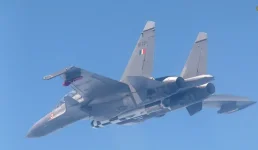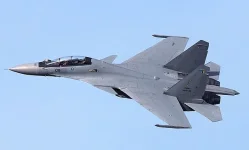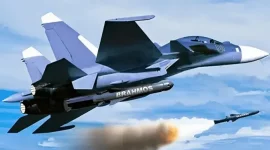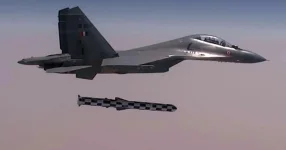- Views: 3K
- Replies: 23
The recent May 2025 engagement between India and Pakistan saw the Indian Air Force (IAF) effectively utilize its Sukhoi Su-30MKI fighter jets, equipped with the BrahMos-A supersonic cruise missile, in a novel capacity as tactical "mini-bombers."
This deployment, part of Operation Sindoor, resulted in highly effective precision attacks against Pakistani military installations and terrorist support systems, marking a significant evolution in India's aerial combat strategy.
The BrahMos-A missile, an air-launched version of the Indo-Russian BrahMos, weighs 2.5 tonnes and has been a crucial addition to the IAF's capabilities. It can travel at speeds up to Mach 3 (three times the speed of sound), has a strike range reported between 400 and 500 kilometres, and carries a warhead of 200 to 300 kilograms.
Its integration with the Su-30MKI platform, successfully first tested in November 2017, effectively converts the versatile fighter into a potent platform for stand-off precision attacks on high-value enemy assets.
Operation Sindoor, conducted on May 6-7, 2025, was initiated following the terrorist incident in Pahalgam on April 22. During this operation, Su-30MKI jets armed with BrahMos-A missiles reportedly targeted nine militant camps across Pakistan and Pakistan-occupied Kashmir.
Indian defence sources indicated that these strikes also successfully hit key Pakistani airfields, such as Nur Khan in Rawalpindi and Sargodha, inflicting damage on runways, aircraft shelters, and facilities suspected of housing sensitive assets.
The BrahMos-A's ability to fly at very low altitudes and perform agile manoeuvres in its final attack phase reportedly allowed it to bypass Pakistan's Chinese-origin HQ-9BE surface-to-air missile (SAM) systems and JY-27A radar networks, achieving high levels of accuracy.
The Su-30MKI's capacity to deploy the BrahMos-A, even if currently limited to a single missile (though future enhancements might allow for two), enables it to deliver a substantial 300 kg payload—comparable to a small tactical bomb—while still retaining its capabilities for other fighter roles.
One observation noted, "The BrahMos-A on the Su-30MKI transformed it into a mini-bomber, striking Pakistani bases with surgical accuracy. This demonstrates true air dominance."
These actions are reported to have led to Pakistan's Director General of Military Operations requesting a ceasefire on May 10. Aviation analyst Tom Cooper has described India's air campaign during this period as a decisive success.
However, the Su-30MKI and BrahMos-A combination, while effective, has inherent limitations. The Su-30MKI is fundamentally a multirole combat aircraft, not a purpose-built bomber. Its weapon payload for such deep strike missions is restricted, typically to one BrahMos-A missile carried on a central fuselage pylon.
Launching this heavy missile also consumes considerable fuel and can temporarily reduce the aircraft's agility, potentially increasing its vulnerability during its exit from hostile airspace.
Furthermore, the Su-30MKI, a 4.5-generation aircraft, does not possess the advanced stealth characteristics necessary to penetrate heavily defended enemy airspace without detection.
While its sophisticated electronic warfare (EW) systems, including the EL/M-8222 jamming pod, and its exceptional manoeuvrability assist in evading missile threats like the PL-15E and HQ-9BE, its relatively large radar signature makes it detectable by modern AESA radars, such as Pakistan's Chinese-supplied KLJ-7A
In the May 2025 operations, the IAF reportedly managed this risk by launching BrahMos-A missiles from outside the engagement range of Pakistani air defences. This standoff approach might prove less viable against an adversary possessing more advanced and integrated air defence networks, such as China’s HQ-22 or S-400 equivalent systems.
The BrahMos-A missile itself, though a powerful weapon, is not designed for the kind of deep strategic penetration missions that require very large conventional payloads or the delivery of nuclear warheads—tasks traditionally assigned to dedicated bomber aircraft.
The IAF's current reliance on its fighter fleet for such roles indicates a potential gap in both its operational doctrine and its available military hardware, particularly as regional security challenges become more complex.
The expanding missile inventories of Pakistan and the strengthening air defence capabilities of China underscore the need for India to develop a platform capable of delivering substantial payloads stealthily over long distances to maintain its strategic advantage.
Experts suggest that India should now focus on the domestic development of a 50-tonne class stealth bomber, potentially leveraging technologies from its ongoing Advanced Medium Combat Aircraft (AMCA) programme, to bolster its long-range strike capabilities and strategic deterrence.
The Imperative for a 50-Tonne Stealth Bomber
The effective use of the BrahMos-A by Su-30MKI jets shows India's capability to creatively adapt existing assets for strategic purposes. However, it concurrently highlights the necessity for a dedicated stealth bomber.A 50-tonne class bomber, incorporating technologies from India's indigenous 5th-generation AMCA fighter program, could address current limitations by offering superior payload capacity, stealth, and operational range.
Prioritizing such a development is seen as crucial for the IAF due to several factors:
- Enhanced Strategic Deterrence and Deep Strike Power: A stealth bomber would be capable of carrying a diverse and heavy assortment of weapons, including the BrahMos-A, the developmental hypersonic BrahMos-II, the Long-Range Land Attack Cruise Missile (LRLACM) with a 1,500 km range, and potentially nuclear armaments. With an estimated payload capacity of 15 to 20 tonnes, it could deploy multiple missiles or bombs in a single mission, a significant advantage over the Su-30MKI's current single BrahMos-A capability. Its operational range, potentially exceeding 5,000 km with aerial refuelling, would allow for strikes against strategic targets deep within enemy territory, such as command and control centres, missile launch sites, or naval fleets. This capability is particularly relevant when considering potential adversaries like China, whose advanced PL-15 air-to-air missiles and HQ-22 air defence systems pose a considerable threat to non-stealth aircraft.
- Superior Stealth and Survivability: The AMCA program, managed by the Aeronautical Development Agency (ADA), is focused on integrating advanced stealth features like a significantly reduced radar cross-section (RCS), specially designed serpentine air intakes to mask engine blades, and radar-absorbent materials (RAM). A bomber derived from AMCA technology could potentially achieve an even smaller RCS, rendering it extremely difficult for enemy radar systems to detect. Furthermore, if equipped with an AMCA-derived AESA radar (such as the Gallium Nitride-based Virupaksha currently under development) and a modern electronic warfare suite, the bomber could effectively jam hostile sensors and deploy countermeasures, greatly enhancing its ability to survive in contested airspace and penetrate sophisticated integrated air defence systems—a task challenging for the Su-30MKI, which primarily relies on standoff weapon launches.
- Synergy with AMCA Technology: The AMCA is designed with a twin-engine configuration, initially using GE F414 engines (each providing 98 kN of thrust) with plans for an indigenous 110 kN engine by 2030. This propulsion technology could be scaled for a larger bomber, possibly using four such engines or a more powerful derivative to meet the thrust requirements of a 50-tonne aircraft. Key AMCA systems, including its advanced fly-by-wire flight control system, integrated sensor network, and artificial intelligence-assisted decision-making tools, could be adapted for a bomber, thereby reducing pilot workload and enabling more complex mission profiles. The internal weapons bay, a standard feature in 5th-generation fighter designs for maintaining stealth, would also be a critical element for the bomber, unlike the Su-30MKI's external weapon pylons.
- Cost-Effectiveness and National Self-Reliance: Developing a stealth bomber by leveraging technologies and experience from the AMCA program would utilize existing research and development, potentially lowering overall costs compared to initiating an entirely new and separate project. The AMCA, which is anticipated to enter production by 2032, will help establish a domestic supply chain for specialized stealth materials, advanced avionics, and jet engines, which could also support the bomber project. This indigenous approach aligns with India's 'Atmanirbhar Bharat' (self-reliant India) policy, reducing dependence on foreign military platforms like Russia's Tu-22M3 or America's B-21 Raider, which are generally not available for purchase or may not be tailored to India's specific operational needs. The success of indigenous systems like the DRDO's Akash missile and the BrahMos cruise missile, which according to defence analyst John Spencer outperformed Chinese counterparts in the recent 2025 events, demonstrates India's growing proficiency in developing world-class defence equipment.
- Regional and International Strategic Importance: The development of an Indian stealth bomber would serve as a countermeasure to China's H-20 stealth bomber, which is reportedly expected to become operational around 2027 with an intercontinental range of 10,000 km and a 45-tonne payload capacity. It would also enhance deterrence against Pakistan's evolving missile and unmanned aerial vehicle (UAV) capabilities, which, as noted in the 2025 conflict, included the use of Chinese-origin Byker YIHA III drones that proved to be of limited effectiveness. On a global scale, a successful stealth bomber program would solidify India's position as a significant innovator in defence technology, potentially attracting interest from other nations seeking advanced military aircraft from sources beyond the traditional American, Russian, or Chinese suppliers.
- Advanced Engine Development: The 110 kN engine planned for the AMCA is still in its early phases of development. A large bomber would necessitate engines with substantially higher thrust, likely in the 150–200 kN class. Achieving this could involve international collaboration with engine manufacturers like Safran or Rolls-Royce, or by significantly advancing DRDO’s indigenous Kaveri engine project.
- Mastery of Stealth Technology for Large Airframes: While the AMCA program provides a foundational understanding of stealth, designing a much larger aircraft that maintains a consistently low radar cross-section across all aspects requires highly advanced computational fluid dynamics modelling, sophisticated manufacturing techniques, and extensive testing facilities, all of which demand considerable investment.
- Financial Investment and Timelines: A stealth bomber development program is estimated to cost between $10 billion and $15 billion and could take 10 to 15 years to reach fruition. A balanced approach might involve prioritising the ongoing AMCA production while simultaneously initiating a detailed feasibility study for the bomber to manage resource allocation effectively.
- Evolution of Air Force Doctrine: The Indian Air Force's current operational doctrine is largely centred around its fighter aircraft fleet. Integrating a strategic bomber would necessitate an evolution in this doctrine, requiring the development of new training protocols, basing infrastructure, and operational employment concepts.
A phased approach, starting with a feasibility study by 2026 and aiming for a prototype by 2035, could align with the AMCA's induction timeline, allowing for maximum technological synergy. Strategic international partnerships, potentially with France for engine technology or Israel for advanced avionics, could help accelerate the development process while ensuring primary indigenous control over the program.
The effective performance of the BrahMos-A missile launched from Su-30MKI fighters in the May 2025 conflict highlighted India's innovative capacity to adapt existing fighter aircraft for strategic strike roles, achieving significant results.
Nevertheless, the inherent limitations of this "mini-bomber" approach—specifically regarding payload capacity, the absence of comprehensive stealth, and vulnerability against advanced integrated air defence systems—underscore the compelling need for India to develop a dedicated stealth bomber.
By capitalising on the technological advancements of the AMCA program, India has the potential to create a 50-tonne platform capable of deep strategic strikes, possessing advanced stealth features, and significantly bolstering its deterrence capabilities against regional competitors.
As noted in some social media discussions on platform X, "BrahMos on Su-30MKI is just the start. A stealth bomber is India’s next big leap!"
Given its established record in indigenous defence innovation, India appears well-positioned to develop such a strategic asset, which could redefine air power dynamics in South Asia and beyond.




